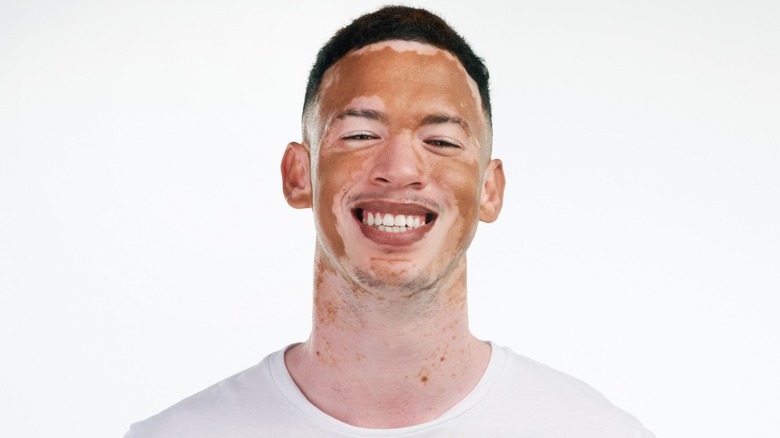A Common Type Of Vitiligo Has A Promising New At-Home Therapy
Vitiligo, an autoimmune disorder that affects the skin, now has a new therapy option available for at-home use (per Healthline). The Food and Drug Administration (FDA) has recently approved the therapy for non-segmental forms of vitiligo, the most common type of vitiligo, for people 12 and older. Vitiligo is a condition that causes discoloration to the skin, leading to white patches. According to the medical journal, Dermatology, up to 2% of the global population has vitiligo, the most common type of depigmenting skin condition.
The primary method for treating non-segmental vitiligo has typically been through light therapy at a health practitioner's office, Healthline reports. Now, it is possible to treat it with a skin cream called Incyte's ruxolitinib, sold under the brand Opzelura. The medication targets the patient's overactive immune system to help restore the skin's pigmentation. However, only those who have non-segmental vitiligo can use this new treatment. There is no similar treatment available yet for those who have segmental vitiligo. Despite this, dermatologist Dr. Erum N. Ilyas told Healthline that this first-ever FDA-approved topical therapy for vitiligo was significant.
Non-segmental vitiligo vs. segmental vitiligo
Mayo Clinic describes vitiligo as not life-threatening and non-contagious. Vitiligo occurs when the cells in the skin that produce melanin – the pigment that gives your skin, hair, and eyes color — die or no longer function properly. It can affect hair as well as skin, and is typically more noticeable on those who have naturally darker skin. Health experts do not yet know the cause of vitiligo, but believe that family history, stress triggers, severe sunburn, and autoimmunity can be factors.
The segmental form of vitiligo is different from non-segmental forms of the disease in several ways, per Medical News Today. For one, segmental vitiligo is far less common. Additionally, it spreads rapidly and then stabilizes where non-segmental takes a progressive course. Segmental vitiligo also has an earlier age of onset and is unilateral, or localized, in nature, meaning the depigmentation is not symmetrical as it is in cases of non-segmental vitiligo.
While the FDA-approved cream is a major breakthrough for those with non-segmental vitiligo, the treatment can take up to several months to show results, per Healthline. In addition, a tube of the topical cream can cost in the neighborhood of $1,300. This may be unaffordable for many since insurance companies typically view treating vitiligo as cosmetic, making it potentially challenging to receive medical coverage for the treatment.


